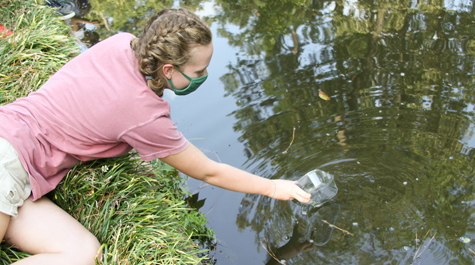Craspedacusta’s Last Stand? Not likely, but now’s the best time to see the Crim Jellies
The Crim Dell jellyfish are back — bigger and more numerous than ever.
Jon Allen says the Craspedacusta jellyfish are having a bloom right now in the Crim Dell pond. The freshwater jellyfish generally lurk unseen, deep in the depths of the pond in their planula and polyp stages. But every few years, the adult forms, known as medusae, make their presence known to the campus as they swarm to the surface in a tentacled — and presumably unfruitful —search for mates.
“My estimate is that at a minimum there are thousands — tens of thousands? hundreds of thousands? —of jellyfish in Crim Dell,” Allen said. “Hopefully we can get a better count this fall to determine just how many.”
Allen, an associate professor in William & Mary’s Department of Biology, said the most recent observed bloom was in 2019. Jellyfish blooms are mysterious and hard to predict, he added.
“When I arrived at William & Mary, I was told that they bloomed every eight years or so,” Allen said. “That pattern held up for one cycle, with a bloom in 2010 and then another in 2019 — a nine-year span. But now we are just two years since the last observed bloom and this one is much bigger than the previous two.”
This year’s bloom just happily coincides with Maria Clagett and Martha Young enrolling in BIOL 302 — Integrative Biology: Animals, taught by Allen.
“They both told me they were interested in jellyfish when we met and I am sure I disappointed them by saying we mostly study other kinds of spineless creatures,” he said. “The return of the Crim Jells coinciding with students interested in jellyfish was just good luck!”
Clagett and another student in BIOL 302, Mariel Webb, both members of the Class of 2024, were the first to see the Crim Jells. Allen said they spotted the medusae from the Crim Dell bridge. During a normal bloom, the jellyfish are too small — dime-sized at best — to be easily seen without having one in your collecting net. But this year’s jumbos are quarter-sized, big and numerous enough for casual, naked-eye jellyfishing.
“They’re probably easier to spot from the sidewalk between ISC and Sadler,” Allen said. “If you walk by when the light is lower in the morning or afternoon, they are pretty easy to see.”
Very little is known about Craspedacusta jellyfish. Allen explained that they are an invasive species, originally from China. They’re found in other ponds, not just Crim Dell. But beyond a few simple facts, Allen says more questions than answers surround the jellyfish. Webb and Clagett have joined Allen’s lab to use the big bloom of 2021 to try to answer at least some of the questions.
One strange set of facts centers around the arcana of Craspedacusta reproduction. Allen explained that the little polyps reproduce asexually, cloning themselves to introduce new generations of Crim Jells. The business of the medusae, however, is to mate and spawn. But the members of a Craspedacusta bloom are almost always one sex or another. It’s the same this year.
“So far, it’s just females — with many eggs!” Allen said. “But no males. Is there sexual reproduction happening in Crim Dell or not? Unclear!”
He said the jelly lab will try to get the Craspedacusta to spawn in vitro, and also investigate whether those egg-laden females will reproduce parthenogenically. It’s not just the exotic reproductive habits of the jellyfish that are unknown; Allen says there is much to nail down in the way of nuts and bolts of the freshwater jellyfish life cycle.
“We don’t even know what prompted this bloom,” he said. “Probably a combination of warm temperatures and abundant food for the jellies, but we don’t actually have a good idea of their diet.”
Allen said the group has begun collaboration with “Flatworm Mom and now jellyfish guru” Anna Klompen ’11, an alumna of the Allen Lab. Klompen now is in graduate school at the University of Kansas.
“Hopefully we can get to a point where she can use some of the Crim Jells in her graduate work,” Allen said. “She has some of the same species in Kansas now, but they are from Japan. Apparently North American populations aren’t available. Hopefully we can change that!”
 Skip to main content
Skip to main content

